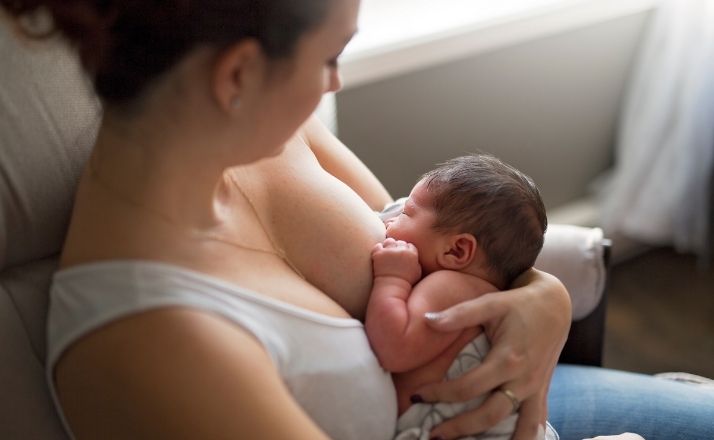If your baby has a lip tie, you may wonder if it’s still possible to breastfeed. The answer is yes! Typically, babies with a lip tie are able to breastfeed successfully, although you may need to make some minor adjustments.
What is a lip tie?
A lip tie is a casual name for when a baby’s labial frenulum is too tight. This leaves the baby’s upper lip closely attached to the gum and can make it more difficult for a baby to move their upper lip freely.
If you examine your own lip/teeth/gums, you will probably see that the thin piece of tissue that attaches your upper lip to your gums is attached up high, near the top of your gums. You’ll also probably notice that the attaching tissue (the labial frenulum) is relatively thin.
If you examine the upper lip of a baby with a lip tie, you’ll often find that the tissue is attached much lower on the gum. Instead of being attached high on the gums (approaching the upper jaw bone), it’s closer to the bottom part of the gums, near where the front teeth will emerge).

Is a lip tie problematic for breastfeeding?
Most experts don’t believe lip ties cause major breastfeeding challenges. Most breastfeeding difficulties can be traced to other things, such as improper technique, poor latch, inverted or flat nipples, etc.
Don’t confuse a lip tie with a tongue tie, which restricts the movement of the tongue. A tongue tie can cause significant breastfeeding difficulties, depending on the severity of the tie.
In a perfect latch, the baby’s mouth will open wide and the lips will fan outward. Often, in a baby with a lip tie, you’ll notice that the upper lip will curl under. Although this isn’t necessarily ideal, it typically doesn’t cause breastfeeding problems. It’s far more problematic if the lower lip curls under.
If your baby’s upper lip curls under and you think it affects their latch, one way to deal with this is to latch the baby. Then, gently pull their upper lip out with a fanning motion.
This can work if the tie is not too severe/tight and the latch is otherwise good overall. Again though, there’s no research indicating it’s necessary to adjust the upper lip placement (though some mothers report anecdotal effects).
Can you fix a lip tie?
Yes, although again, this may be unnecessary. There’s little to no evidence suggesting the presence of a lip tie ultimately affects the placement of teeth, feeding, etc.
Some doctors believe in leaving a lip tie alone. Others will revise it (the official term for cutting or lasering the excess connection between the lip and the gum).
For perspective, all of my babies had lip ties. We had plenty of struggles with breastfeeding, but their lip ties weren’t among them.
Our pediatrician’s approach is not to revise lip ties before two or three years of age, unless they’re proving problematic. In his experience, most kids fall and break the excess connection at some point on their own.
That proved true for us. I have four boys (the youngest is about to be 2). The oldest three all fell and busted their upper lip (some more than once), breaking the extra connecting tissue. I guess that’s one perk to raising rowdy boys!
Doctors are diagnosing lip ties with greater frequency, but their approaches still vary widely. If you think your baby has a lip tie, definitely discuss it with your pediatrician and/or lactation consultant. They can guide you on how to best proceed.











